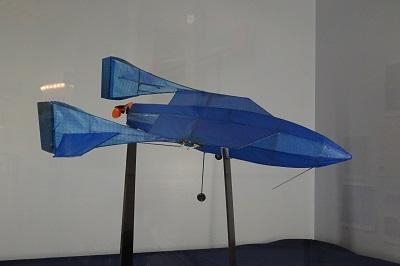Mon, Apr 11, 2016
The National Model Aviation Museum Receives Piece Of Aerospace History
Model aircraft have played a large part in the development of aeronautics for years. The brothers Orville and Wilbur Wright used model airfoils to validate their theories for lift, center of lift shifting, and aircraft control. In this modern day and age of computers it may seem odd that a model aircraft was used in developing techniques to return a spaceship to earth; but that’s just what Burt Rutan did.

Now, National Model Aviation Museum is thrilled to announce its exhibit of the SpaceShipOne RC test model. This piece of aerospace history is significant because it proved the viability of an experimental, nongovernment-funded concept and was flown in front of pilots who would later fly the full-scale aircraft.
In 2004, SpaceShipOne became the first privately built and operated vehicle to achieve manned supersonic spaceflight. The purpose of the program was to accelerate the development and reduce the cost of spaceflight, specifically for commercial passenger use. SpaceShipOne was later retired and is on display at the Smithsonian National Air and Space Museum.
Designed by Burt Rutan, SpaceShipOne was unique in its application of a “feathering” re-entry system. The rear half of the wing and the twin tail booms fold upward along a hinge running the length of the wing, increasing drag while remaining stable.
“It is amazing to see a state-of-the-art, Mach 3-plus aircraft, with a test model made of kite fabric [and] powered by an electric motor,” said Michael Smith, National Model Aviation Museum director. “While computers have become an ever-increasingly important tool in the development of aircraft, engineers still use flying models for aircraft research.”
The model is currently on display at the National Model Aviation Museum at AMA Headquarters in Muncie, IN. To learn more about the museum and its collection of more than 11,000 model aircraft artifacts, use the link below.
(Image provided by the National Model Aviation Museum)
More News
From 2021: The Inside Skinny On What Being An ANN Oshkosh Stringer Is All About By ANN Senior Stringer Extraordinare, Gene Yarbrough The annual gathering at Oshkosh is a right of p>[...]
Video Showed That During The Takeoff, The Nose Baggage Door Was Open On May 10, 2025, about 0935 eastern daylight time, a Piper PA-32RT-300, N30689, was destroyed when it was invol>[...]
Get The Latest in Aviation News NOW on Instagram Are you on Instagram yet? It's been around for a few years, quietly picking up traction mostly thanks to everybody's new obsession >[...]
"I think what is key, we have offered a bonus to air traffic controllers who are eligible to retire. We are going to pay them a 20% bonus on their salary to stay longer. Don't reti>[...]
Aero Linx: Pilot Briefing The gathering, translation, interpretation, and summarization of weather and aeronautical information into a form usable by the pilot or flight supervisor>[...]
 Oshkosh Memories: An Aero-News Stringer Perspective
Oshkosh Memories: An Aero-News Stringer Perspective NTSB Prelim: Piper PA32RT
NTSB Prelim: Piper PA32RT ANN FAQ: Follow Us On Instagram!
ANN FAQ: Follow Us On Instagram! Aero-News: Quote of the Day (05.28.25)
Aero-News: Quote of the Day (05.28.25) ANN's Daily Aero-Term (05.28.25): Pilot Briefing
ANN's Daily Aero-Term (05.28.25): Pilot Briefing



